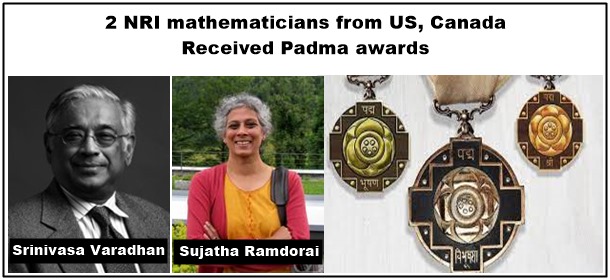 |
2 NRI mathematicians from US, Canada
Received Padma awards

Los Angeles, Jan 26, 2023
NRIpress.club/Ramesh/ A.Gary Singh
2 NRI mathematicians are among the 106 recipients of the prestigious Padma awards, one of the highest civilian honours of the country, announced on the eve of the Republic Day.
The Padma Awards are given in three categories:
- Padma Vibhushan (for exceptional and distinguished service),
- Padma Bhushan (distinguished service of higher order)
- Padma Shri (distinguished service).
About Srinivasa Varadhan
Since 1963, he has worked at the Courant Institute of Mathematical Sciences at New York University, where he was at first a postdoctoral fellow (1963–66), strongly recommended by Monroe D Donsker. Here he met Daniel Stroock, who became a close colleague and co-author.
Varadhan, whom everyone calls Raghu, came to these shores from his native India in the fall of 1963. He arrived by plane at Idlewild Airport and proceeded to Manhattan by bus. His destination was that famous institution with the modest name, The Courant Institute of Mathematical Sciences, where he had been given a postdoctoral fellowship. Varadhan was assigned to one of the many windowless offices in the Courant building, which used to be a hat factory. Yet despite the somewhat humble surroundings, from these offices flowed a remarkably large fraction of the post-war mathematics of which America is justly proud.
Varadhan is currently a professor at the Courant Institute.He is known for his work with Daniel W Stroock on diffusion processes, and for his work on large deviations with Monroe D Donsker. He has chaired the Mathematical Sciences jury for the Infosys Prize from 2009 and was the chief guest in 2020.
Education
- Ph.D., Mathematics, Indian Statistical Institute, India, 1963.
- M.A., Mathematics, Presidency College, Madras, India, 1960.
- B.A., Mathematics, Presidency College, Madras, India, 1959.
Research Interests
- Srinivasa Varadhan interested in probability theory and its relation to analysis. In particular Varadhan interested in various aspects of stochastic processes and their connections to certain classes of linear and nonlinear partial differential equations.
Selected Publications
- Y. Kifer and S.R.S. Varadhan, "Nonconventional large deviations theorems", Probability Theory and Related Fields 158, no. 1-2, 197-224 (2014)
- Y. Kifer and S.R.S. Varadhan, "Nonconventional limit theorems in discrete and continuous time via martingales", Annals of Probability 42, no. 2, 649-688 (2014)
- S. Sethuraman and S.R.S. Varadhan, "Large deviations for the current and tagged particle in 1D nearest-neighbor symmetric simple exclusion", Annals of Probability 41, no. 3A, 1461-1512 (2013)
------------------------------------------------------
NRI Srinivasa
Varadhan, mathematician wins prestigious Abel prize close to US
1 million
OSLO, May 23, 2007
Satinder Paul
NRI Srinivasa Varadhan, 67, mathematician received the prestigious
Abel Prize for his fundamental contributions to probability theory
and in particular for creating a unified theory of large deviations.The
Abel Prize, awarded by the Norwegian Academy of Science and Letters
for outstanding scientific work in the field of mathematics, carries
a cash award of close to 1 mill. USD.
Probability theory is the mathematical tool for analyzing situations
governed by chance. The theory of large deviations studies the occurrence
of rare events. This subject has concrete applications to fields
as diverse as physics, biology, economics, statistics, computer
science, and engineering.
Varadhan’s theory of large deviations provides a unifying
and efficient method for clarifying a rich variety of phenomena
arising in complex stochastic systems, in fields as diverse as quantum
field theory, statistical physics, population dynamics, econometrics
and finance, and traffic engineering. It has also greatly expanded
our ability to use computers to simulate and analyze the occurrence
of rare events. Over the last four decades, the theory of large
deviations has become a cornerstone of modern probability, both
pure and applied.
“Varadhan’s work has great conceptual strength and
ageless beauty. His ideas have been hugely influential and will
continue to stimulate further research for a long time”, to
quote the Abel Committee.
The Abel Prize was created by Norway's government in 2002 to mark
the 200th anniversary of the birth of the great Norwegian mathematician
Niels Henrik Abel. The Abel Committee's citation and the biography
of the prize-winner, translated into 12 languages, will give more
information.
The Abel Prize is this year awarded for the fifth time. The first
Abel Prize was awarded in 2003 to Jean-Pierre Serre, Collège
de France. In 2004 the Abel Prize was shared between Sir Michael
Atiyah, University of Edinburgh and Isadore Singer, Massachusetts
Institute of Technology. Peter D. Lax, Courant Institute of Mathematical
Sciences, New York University, was the 2005 Abel Laureate. Lennart
Carleson, Royal Institute of Technology, Sweden was awarded the
Abel Prize in 2006.
BIO:
NRI (NON-RESIDENT INDIAN) Sathamangalam R. Srinivasa Varadhan,
probabilist. was born January 2, 1940 in Madras (Chennai), India.
-
Ph.D. 1963 (statistics), Indian Statistical
Institute;
-
M.A. 1960 (statistics), B.Sc. (honors) 1959
(statistics), Madras.
- Since 1963, he has worked at the Courant Institute of Mathematical
Sciences at New York University, where he is currently (as of
2007) a professor.
- Varadhan is known for his work with Daniel W. Stroock on diffusion
processes, for which he received the Steele Prize from the American
Mathematical Society in 1996.
- For his work on large deviations with Monroe Donsker, for which
he was awarded the Abel Prize on March 22, 2007 by the Norwegian
Academy of Science and Letters
Srinivasa Varadhan is married to Vasundra, also a professor at
New York University. The elder of Varadhan's two sons, Gopal was
killed in the attacks on the World Trade Center on September 11,
2001.

|
